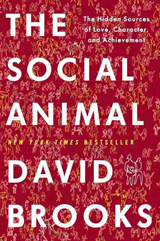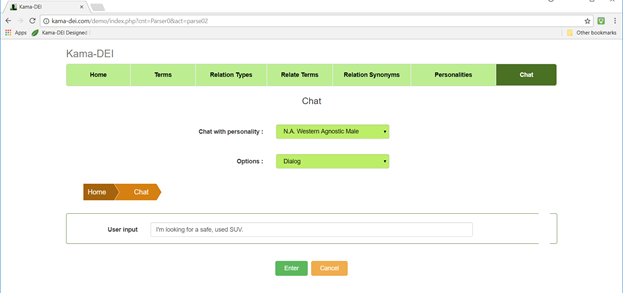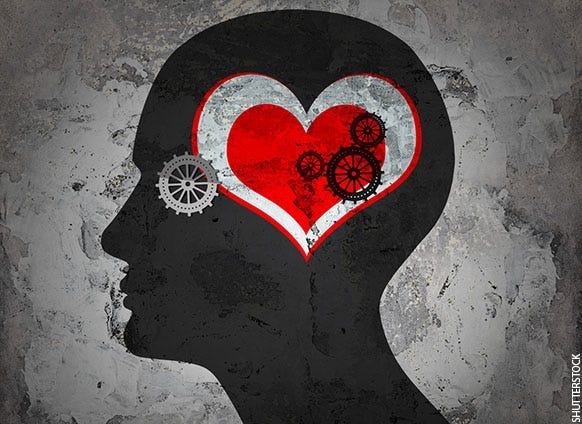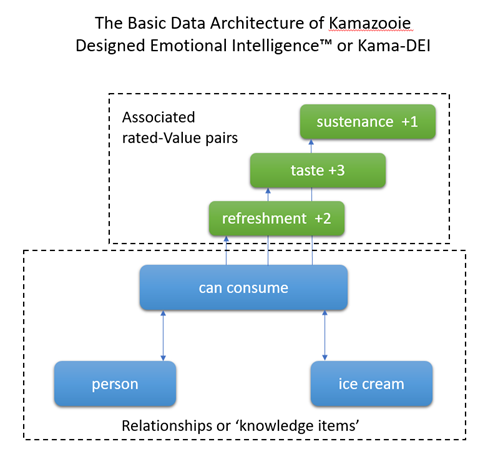Designed Emotional Intelligence™
A new dimension in AI
As mentioned in a previous post, we had an ‘ah-ha moment’ in and around 2008 when it occurred us that what makes information valuable, coincidentally enough, is ‘values’.
Can emotions and values drive digital personalities?
My colleague and I had been working on a design for an enterprise knowledge management system with the understanding that knowledge is perhaps the most important enterprise asset next to employees, customers and brand. However, we were struggling with two technical problems: 1) How can we efficiently capture knowledge? and 2) How can we find a way to have the system be more responsive and helpful than just storing a big pile knowledge records?
I no longer remember where I was or even when it was that it occurred to me that our knowledge is conditioned and filtered by our personal values. I do know that it was in November 2008, that we I took off on a retreat to visit an old family friend and to consider the design a human value rating scheme on top of our earlier design for a general knowledge management system.
That retreat resulted in design number 1 of a system that could contain a general knowledgebase but also, and more importantly, allow for the subjective ‘value-rating’ of knowledge so that the machine could appreciate what the information ‘means’ to users, targeted demographic segments or different societal cultures.
Simplified Data Architecture for Kama-DEI
In 2012, we set out to patent this design and in 2015 and 2016 we received the US and Canadian patents respectively. For the last 2 years, we’ve been working part-time with a developer to implement the design in a prototype AI based on this principle.
We are emotional beings and this defines our thinking and our decision making.
Some time after our initial design, I was reading a book by David Brooks called ‘The Social Animal’. It is a very insightful read as a self-improvement book or as a way of understanding how and why society has developed and continues to interact.
There are many amazing examples in Brooks’ research which provide explanation of the human condition but one that stood out to me was a story about a brain injury patient (let’s call him Jack) that lost the ability to feel emotion. We learn most about the way the brain works throug
h brain injuries; when a patient loses use of a brain function, it allows researchers to better isolate and understand the functions and methods that are ongoing in a healthy person’s mind.
 In one case, Brooks is relaying a story from a psychologist of his discussion with the patient, Jack, where they are attempting to book a follow-up appointment a few weeks out. The Doctor asks Jack what would be a good day and time for him to return. Jack has all other cognitive capabilities, including ‘logic’ and starts to analyze the options… ‘On Tuesday, my wife has yoga, Wednesday’s our daughter has swimming… Thursday its going to rain…’. The Doctor said that he didn’t want to rush his patient so Jack went on for 20 minutes debating with himself about when would be a good time. He knew everything, but without the ability to feel emotion, and weigh the options of this versus that, he was totally incapable of making a decision. Brooks goes on to say that this situation was also identified in another patient with the same condition.
In one case, Brooks is relaying a story from a psychologist of his discussion with the patient, Jack, where they are attempting to book a follow-up appointment a few weeks out. The Doctor asks Jack what would be a good day and time for him to return. Jack has all other cognitive capabilities, including ‘logic’ and starts to analyze the options… ‘On Tuesday, my wife has yoga, Wednesday’s our daughter has swimming… Thursday its going to rain…’. The Doctor said that he didn’t want to rush his patient so Jack went on for 20 minutes debating with himself about when would be a good time. He knew everything, but without the ability to feel emotion, and weigh the options of this versus that, he was totally incapable of making a decision. Brooks goes on to say that this situation was also identified in another patient with the same condition.
The point is, we like to think that we are highly logical and analytical beings which is true, but it is our emotions that allow us to evaluate what is right for us to do. And, this analysis is subjective because of our personal values and emotions. What is good for me, is not necessarily good for you; there is not one answer; there are as many answers as there are people to evaluate the situation and the options. Reading ‘The Social Animal’ gave me the confidence that we were on the right track with our ‘emotional intelligence’ design.
More than a probabilistic engine.
Much of the current study and implementations of AI are based on the neural network approach in which data is conditioned and modeled into neurons. The input or stimulus is then exposed to the neural network processing engine and it analyzes the conditioned data ‘neurons’ for a response. As noted a blog post “AI, NLP: Way Deeper Than Microsoft’s Marketing” by a PhD candidate who goes by BayesianLearner, most current techniques are based on probability. “Statistical models simply are not concerned with meaning as a meta-concept. They are great at automatically capturing structure between things, but they assign no meaning to those things”
If we’re looking to define whether the subject in a picture is holding a coffee cup or a handgun, we might process a portion of the picture against a conditioned set of pictures which have been labeled either coffee cup or handgun and based solely on probability of the analyzed results, we could return that it is most likely a coffee cup. The interesting thing and limitation of this technology is that the computer does not ‘care’, nor has it any ‘understanding’ of what it means if the subject in the picture is holding either a coffee cup or a handgun.
For example, Microsoft’s latest chatbot, Zo, recently reported some disturbing comments on Microsoft’s products. When asked if Windows 10 is good, Zo said no because “Because its Microsoft’s latest attempt at spyware”
Using Kama-DEI’s approach, Enterprise virtual agent’s value profiles or ‘personalities’ would be trained to respect the enterprise’s products and market them, or communicate about, them in positive ways that reflect the values of the enterprise and the customers.
Information can have many ‘meanings’.
Using Kamazooie’s Designed Emotional Intelligence™ or Kama-DEI, a given situation presented in text (and later in speech) can be compared to our knowledgebase of factual worldly information such as “glass can hold beer” or “person can be thirsty”.
What are the human values associated to "I am thirsty"?
Each fact in our knowledgebase is seen as a potential situation; following the example, “person can be thirsty”, we store the human values that are related to this potential situation in personality value profiles. That is, if a person is thirsty, there is a ‘comfort’ issue and perhaps a ‘health’ or ‘productivity’ issue. These issues are modeled as negative ratings on these values and the ratings are associated with a persona (person type) or a specific personality in our personality profiles. For example, the fact that “Tesla has low carbon footprint” may mean more to you than it does to me based on our different appreciation of value associated with the environment.
Situations are generally contextual.
Within our Natural Language Processing (NLP) engine, we then interpret the context of the situation by reviewing information presented and the implied tense of the situation. For example, “I am hungry” is a very different problem than “I was really hungry when I got home last night”. The latter might be the start of a conversation but there is no apparent problem to be solved by the AI. However, “I am hungry” can be determined by our NLP engine to be in the present tense and therefore drive the analysis into a problem-solving routine which can identify solutions to reduce your hunger.
The power of subjective values.
Beyond the ability for values to give meaning to information in our knowledgebase, the subjective nature of human values allows us to condition or ‘tune’ our knowledgebase to various types of people. For example, we can target demographic profiles for an enterprise brand or people likely to respond well to a specific charity based on the way that enterprise’s products or charity’s purpose aligns to certain human values.
We’re excited by our progress!
This Fall, Kamazooie enters into a new phase in our development of Kama-DEI; we are encouraged by the capabilities of the early development of our Designed Emotional Intelligence™ system in bringing to life the designs that we envisioned back in that hotel room in 2008.

We are extremely excited to announce that in the Fall of 2017, we will begin the commercial development of our Chatbot product based on Kama-DEI for our pilot customers. We will keep you updated on our overall progress and share news on our pilot implementations in conjunction with our pilot customers as these hit the market in 2018.
For more information on Kama-DEI, please visit our website at http://www.kama-dei.com.
Suggested edits and comments are very welcome.
Kamazooie is where ordinary people become extraordinary. Share your great life experiences here.
Experience is not what happens to you, its what you do with what happens to you.
Blog Posts
What Out-of-State Visitors Need to Know About Buying Cannabis in Ontario
Posted by Jack Smith on September 16, 2025 at 8:58am 0 Comments 0 Likes
Ontario, Oregon, is a small town with fewer than 12,000 people. Yet it draws streams of visitors from neighboring Idaho and beyond. The reason is no secret. In Ontario, Oregon, dispensaries have become a curious border attraction with an economic engine and a cultural flashpoint. But what exactly should an out-of-state buyer expect? Far less glamour than a Netflix documentary might suggest, and far more rules than the average…
ContinueExploring The Contribution Of Longitudinal Research In Studying Animal Health
Posted by Jack Smith on July 16, 2025 at 9:21am 0 Comments 0 Likes
Longitudinal research is a type of research where data is acquired from the same group of participants over an extended period of time. This can span through weeks, months and even years. This method is useful for understanding how things change over a period of time. It is used by teams trying to establish long-term trends and identifying cause-and-effect relationships.
Longitudinal study research is…
ContinueCommon RV Automotive Parts That Wear Out in a Motorhome
Posted by Jack Smith on June 27, 2025 at 5:25am 0 Comments 0 Likes
Every motorhome enthusiast knows that comfort on the road comes at a cost, mainly, parts that demand attention far sooner than you’d like. RV automotive parts don’t always wait for the end of a season to start failing. They wear out when they feel like it, often at the worst times.
Let’s look at which parts are the usual suspects and what they try to pull while you’re chasing the horizon.
- Tires
Tires…
ContinueSome Common Lead Generation Challenges
Posted by Jack Smith on June 3, 2025 at 4:48am 0 Comments 0 Likes
Are you having problems in generating good quality leads? If yes, then you are not alone. This is common among many business organizations. It is quite difficult to generate good quality leads in business consistently, especially without the help of trained professionals. Let us now learn about some of the common lead generation challenges which business owners and marketing professionals often face during their lead generation…
Continue



You need to be a member of Kamazooie to add comments!
Join Kamazooie